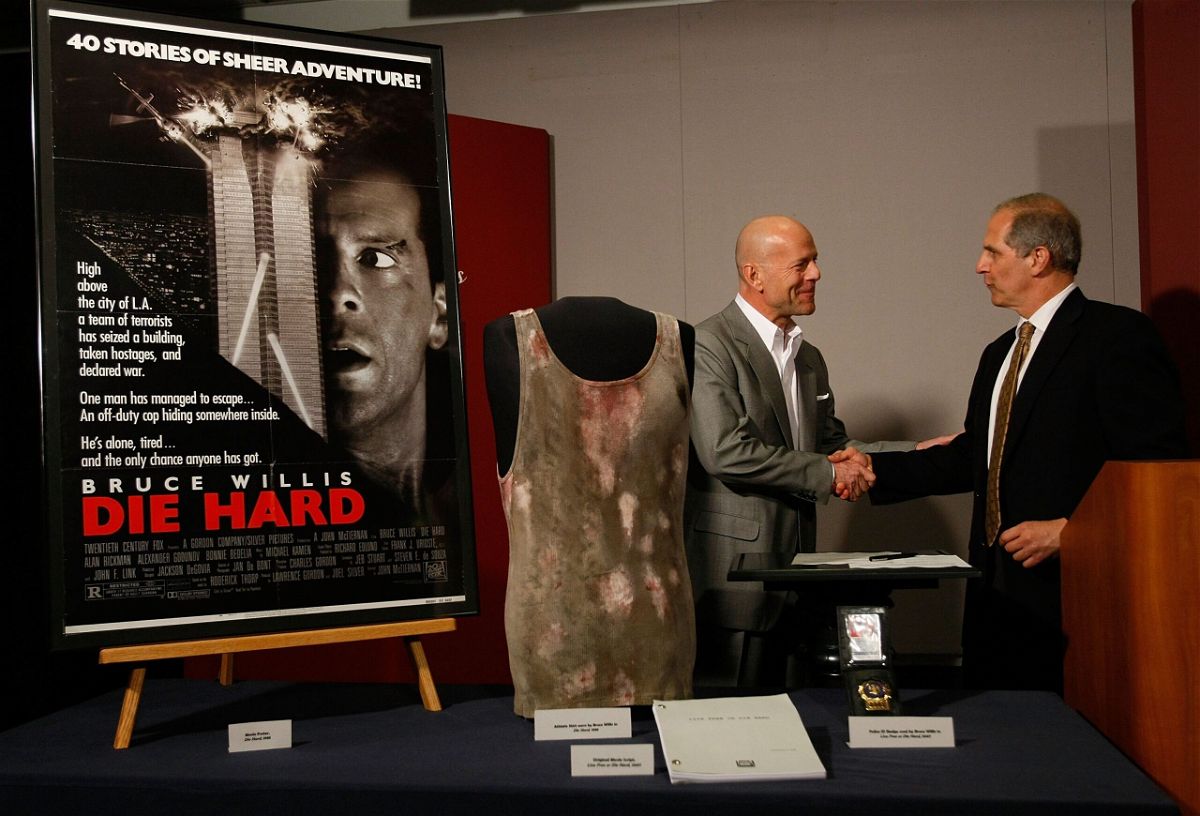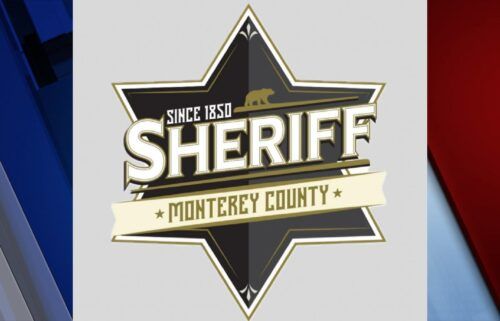Remember when Bruce Willis’ ‘Die Hard’ character fought terrorists at a Christmas party in a tank top?

Bruce Willis presenting the National Museum of American History with props from the "Die Hard" series in 2007
Megan C. Hills
Remember when Bruce Willis’ character in “Die Hard” fought a group of terrorists at an office Christmas party, barefooted and wearing a tank top?
Throughout the movie, Willis, who played John McClane, sported a white undershirt that got progressively dirtier and bloodier — a sight so legendary that a screen-worn version of the garment was acquired by the Smithsonian in 2007.
The film, which spawned four sequels, shifted the narrative of “Rambo”-style invincible action heroes and paved the way for more grounded protagonists. And this was thanks, in part, to its clever costume design.
The deliberately simple outfit was a far cry from the tactical gear worn by Colonel John Matrix in “Commando,” or the impeccable suits favored by James Bond. Instead, McClane — wearing a basic item found in most people’s closets — represented the everyday Joe thrown into an extraordinary situation.
In a 2016 interview with entertainment platform Home Theater Forum, the movie’s costume designer, Marilyn Vance, said that outfits “have to serve the story and serve the character.”
“How was he going to get undressed?” she is quoted as saying, discussing how the plot line unfolds. “How did he wind up without shoes on?”
When we first meet McClane, the New York detective has just arrived in Los Angeles and is inappropriately dressed for the blazing weather in a flannel shirt and corduroy jacket. He scowls at the athleisure-wearing Californians as he heads to his wife Holly’s office for an ill-fated Christmas party, his suit thrown over his arm.
Surrounded by Holly’s colleagues, all dressed in power suits, he heads to the bathroom to freshen up and get changed, briefly kicking off his shoes to relax and curling his toes on the carpet. But as he’s getting dressed, terrorists led by Alan Rickman’s Hans Gruber storm the building.
With no time to grab his shoes, McClane faces off against Rickman’s gang who, as co-screenwriter Steven E. de Souza described in the “Script Apart” podcast, are dressed like “the Eurotrash guys we see in the nightclubs.” McClane’s outfit, in contrast, conveys his unpreparedness.
From underwear to everyday staple
White tank tops have become ubiquitous in fashion: an often inexpensive item that can be worn by anyone, and a form-fitting silhouette that is both functional and sexy.
Mass produced by the clothing brand Jockey from 1935, and originally intended to be worn as underwear, the garment eventually became associated with athleticism, according to textile artist and costume researcher Urs Dierker.
In his 2019 paper “Every stain a story: The many dirty undershirts of John McClane in ‘Die Hard,'” Dierker suggested the shift from undergarment to outerwear happened as images of 1930s athletes competing in tank tops at the Olympic Games and US servicemen wearing white T-shirts in World War II (instead of wearing them under their uniforms) entered mainstream media.
In time, the item would also become associated with the working class and immigrants in America, particularly Italian-Americans.
Hollywood helped cement this idea through movies like “A Streetcar Named Desire,” starring Marlon Brando, and “Bonnie and Clyde,” starring Warren Beatty, where the tank became a “symbol for injustice and class” as well as for “male sexuality and violence,” according to Dierker.
The garment was also loaded with connotations of White masculinity and fast-paced action, worn by the likes of Robert De Niro in “Raging Bull,” Paul Newman in “The Sting” and Sylvester Stallone in “Rambo.” (Bruce Lee also wore one in “The Way of the Dragon,” but this was a rare exception in the White American action hero genre.)
By the time “Die Hard” hit theaters in 1988, the undershirt’s visual vocabulary was well established, quickly communicating McClane’s rebellious, working class character, while emphasizing his strength (like its predecessors, the form-fitting silhouette accentuates toned figures).
Vance has revealed that she created 34 of the tank tops in total: 17 for Willis and another 17 for his stunt double, Keii Johnston. As the movie progresses, they come to reflect the toll of McClane’s heroism — going from pristine white to dirty green, discolored by faux bloodstains and Willis’ actual sweat during production.
The character’s transformation into an all-American, all-guns-blazing 1980s hero reaches its zenith when the top is stripped off completely. (McClane uses it to wrap his bloodied feet toward the movie’s climax, as he comes to terms with how he’s failed the estranged wife he was trying to win back. “She’s heard me say I love you a thousand times, but she’s never heard me say ‘I’m sorry,'” he says emotionally into a walkie talkie).
The “cowboy,” now bare-chested, is ready for a final showdown with his enemy.
A humble legacy
Today, the tank continues to symbolize male heroism in cinema, from the muscle-bearing tops worn by Vin Diesel’s Dom Toretto in the “Fast & Furious” franchise to Michael B. Jordan’s Adonis Creed in “Creed.” Chris Evans as Captain America and Hugh Jackman as the anti-hero Wolverine in the “X-Men” movies have also worn them to fight evil.
But as women protagonists have entered the action hero space, the tank top has come to represent female empowerment, too — in the late 1970s with “Alien” and later in “Terminator 2” and the “Tomb Raider” series. Characters in these movies battle extraterrestrial creatures, escape from murderous robots and explore ancient ruins, all dressed in the staple garment. The tank top tradition also lives on through characters such as Charlize Theron’s Furiosa in “Mad Max: Fury Road” and Kristen Stewart’s Sabina Wilson in “Charlie’s Angels.”
When one of Bruce Willis’ “Die Hard” tank tops was donated to the Smithsonian’s National Museum of American History, the item secured its legacy alongside cinematic costumes including Dorothy’s ruby slippers from “The Wizard of Oz” and Indiana Jones’ wide-brimmed fedora and coat.
And while many costumes from Vance’s storied career will be fondly remembered — such as Molly Ringwald’s bubblegum dress from “Pretty in Pink” or Judd Nelson’s trench coat from “The Breakfast Club” — Willis’ grime-stained tank will remain among her most recognized, with the top even sent to the V&A Museum in London for an exhibition in 2012.
“It is funny,” she told Dazed magazine that year, “the array of films I’ve done, that I’m represented by a white vest!”
The-CNN-Wire
™ & © 2021 Cable News Network, Inc., a WarnerMedia Company. All rights reserved.


